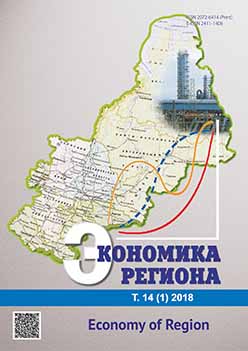Критерии успешности проектов пространственного развития на основе межрегиональной интеграции
Performance Criteria of Spatial Development Projects Based on Interregional Integration
Author(s): Elena Viktorovna Kurushina, Mikhail Borisovich PetrovSubject(s): Economy, Geography, Regional studies
Published by: Институт экономики Уральского отделения Российской академии наук
Keywords: spatial development; strategy; polarized development; endogenous growth; macro-regions; interregional projects; methodological principles; evaluation criteria; integration; typology of regions;
Summary/Abstract: The search of efficient ways for the development of regional socio-economic space is a relevant problem. The authors consider the models of spatial organization according to the Spatial Development Strategy of the Russian Federation until 2030. We conduct the comparative analysis of scenarios for the polarized and diversified spatial growth. Many investigations consider the concepts of polarized and endogenous growth. This study proposes a methodology to assess the development of macroregions and to increase the viability of interregional integration projects. To develop this methodology, we formulate scientific principles and indirect criteria of the project performance conforming to the theory of regional integration. In addition to the territorial community and complementarity of the development potentials, regional integration in the country should be based on the principles of security, networking, limited quantity and awareness of the potential project participants. Integration should ensure synergetic effects and take into account cultural and historical closeness, that manifests in the common mentality and existing economic relations among regions. The calculation results regarding the indirect criteria are obtained using the methods of classification and spatial correlation. This study confirms the hypothesis, that the formation of the Western Siberian and Ural macro-regions is appropriate. We have concluded this on the basis of the criteria of economic development, economic integration, the similarity of regional spaces as habitats, and a number of participants for the subjects of the Ural Federal District. The projection of the patterns of international economic integration to the interregional level allows predicting the highest probability for the successful cooperation among the Western Siberian regions with a high level of economic development. The authors’ method has revealed a high synchronization between the economies of Sverdlovsk and Chelyabinsk Regions. This synchronization increases the chances for successful integration into the Ural macro-region. The same criterion reveals the economic grounds for the productive cooperation between the Sverdlovsk Region and Yamal-Nenets Autonomous District. The application of the regional typology in terms of the mental characteristics provides fewer grounds for the optimistic forecasts in the social projects of interregional integration
Journal: Экономика региона
- Issue Year: 14/2018
- Issue No: 1
- Page Range: 176-189
- Page Count: 13
- Language: Russian

